Do you have thin hair and want to make it look fuller and more natural? Tape-in extensions are an ideal choice thanks to their safety for natural hair and the beautiful, seamless finish they provide.
This guide from Govihair will walk you through everything—from how to apply tape in extensions for thin hair, choosing the best tape extensions for thin hair, to tips on hiding the tapes and aftercare, so your extensions stay long-lasting and damage-free.
Are Tape-in Extensions Good For Thin Hair?
If you have fine or fragile hair, you may wonder if tape-in hair extensions for fragile hair are safe. The truth is, Tape-in hair extensions are one of the least damaging hair extension methods available today — if done correctly and maintained carefully.
Why Tape-ins Are Considered Ideal for Thin Hair
Tape-ins are lightweight, flat, and designed to distribute weight evenly across the scalp, preventing strain on natural hair. Unlike bulky methods, the best tape-in hair extensions for fine hair do not put unnecessary stress on delicate roots.
When applied correctly by a certified stylist, they look natural, feel comfortable, and help you achieve fuller, thicker hair safely.
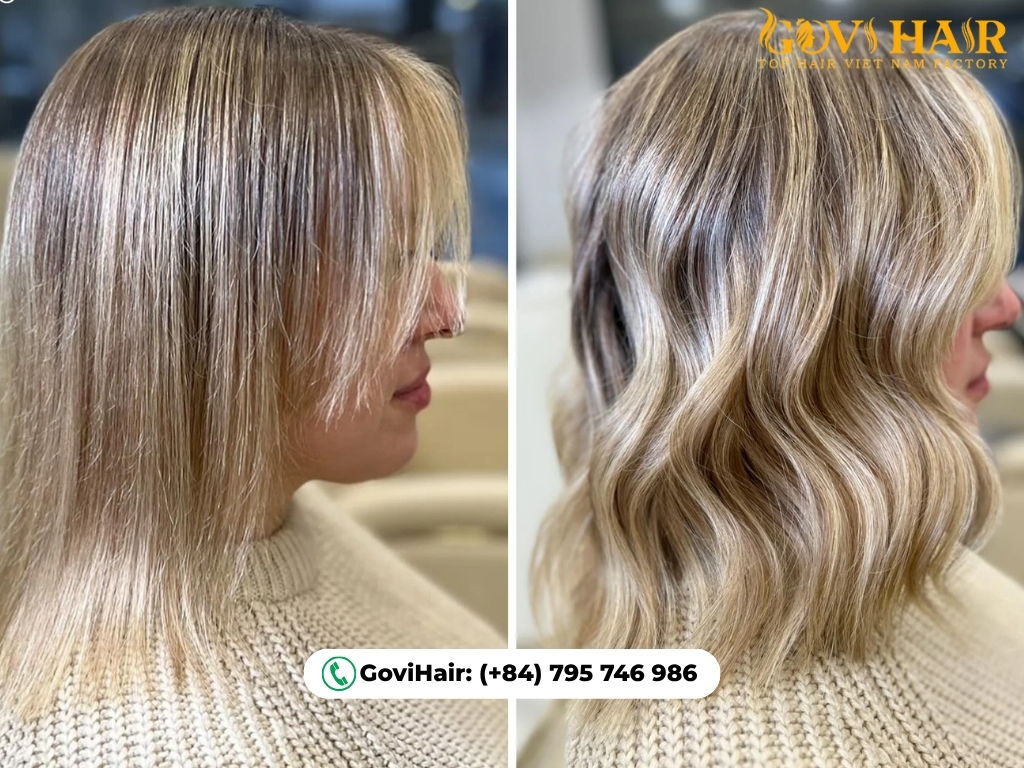
The Pros and Cons of Using Tape-ins on Thin Hair
Pros: Tape-in extensions are an excellent choice for thin hair primarily because they offer a flat, seamless application that results in a very natural look. This makes them easy to blend and style without creating unnatural bulk. Additionally, their reusability makes them a sound long-term investment.
Cons: The main challenge for thin hair is ensuring the tapes remain concealed. This requires a skilled stylist to avoid visibility when the hair moves. They also demand a proper care routine, using specific products to protect the adhesive bonds from weakening.
How to Prepare for a Tape-in Extension Installation on Thin Hair
How to Choose the Best Tape-in Extensions for Thin Hair
Selecting the best tape extensions for thin hair is crucial. Look for lightweight wefts and even consider single sided tape in hair extensions for thin hair if your hair density is very low.
At Govihair, we offer two types of tape specifically suitable for thin hair:
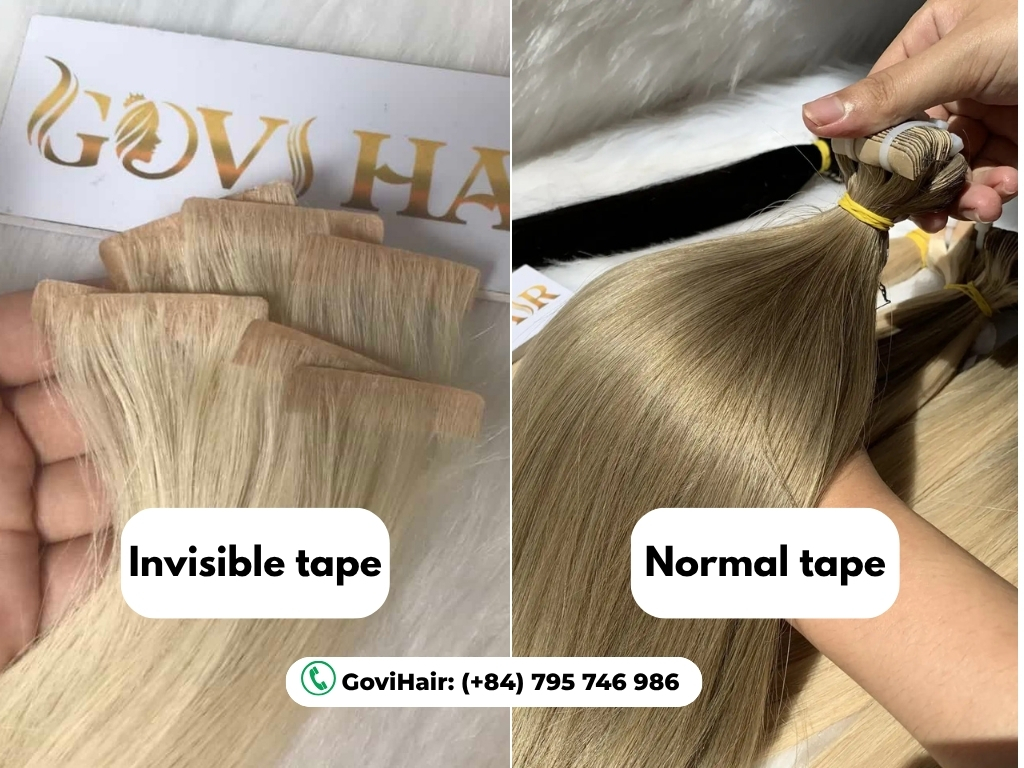
- Normal Tape – affordable and easy to apply.
- Invisible Tape – ultra-thin and discreet, perfect for fine or thin hair.
>>Read more: What Are the Different Types of Hair Extensions? The Complete Guide
The Essential Tools You Will Need
- Tape-in hair extensions (Normal Tape or Invisible Tape)
- Rat-tail comb
- Hair clips
- Scissors (for trimming if needed)
- Flat iron (for styling after application)
How to Properly Wash and Dry Your Hair Before Application
Make sure your hair is clean and completely dry. Do not use conditioner or any oily products before application.
How to Apply Tape in Extensions for Thin Hair (A Step-by-Step Guide)
Section the Hair into Thin Layers
- Start from the bottom layer near the nape of the neck.
- Use the rat-tail comb to create a horizontal parting, about 1 – 1.5 cm wide.
- Clip the rest of the hair up to keep it out of the way.
Select a Thin Strand of Hair
- Take a very thin section of hair, about the same width as the tape.
- Make sure the section is not too thick, so the tape can seal properly and won’t feel bulky.
Apply the Tape
- Step 1: Peel off the backing of the first tape piece and place it underneath the hair strand, about 1 cm away from the scalp.
- Step 2: Peel off the second tape piece and press it on top of the strand, sandwiching the natural hair in between the two tape wefts.

Pro Tips from Govihair for your thin Hair:
If the hair is very thin, you can use a single tape weft on top only (single-sided tape).
- Opt for Invisible Tape for a more natural, seamless look.
Press Firmly
- Use your fingers or flat clips to firmly press the tapes together for 5–10 seconds, ensuring they stick securely.
Repeat for the Rest of the Hair
- Continue sectioning the hair and applying the tapes.
- Avoid placing tape extensions too close to partings or the temples to prevent them from being visible.
>>Read more: How to Apply Tape In Hair Extensions Easy At Home
Aftercare Instructions
Once you know how to apply tape-in extensions for thin hair, it’s essential to follow proper aftercare routines to prevent damage and keep your hair looking natural:
- Do not wash your hair for 24–48 hours after installation.
- Use only conditioner to gently cleanse the hair, and avoid shampoos if possible. If needed, use sulfate-free shampoo.
- Brush gently, starting from the ends upward. Avoid tugging at the tape area.
- Do not use flat irons or curling wands too close to the tape bonds.
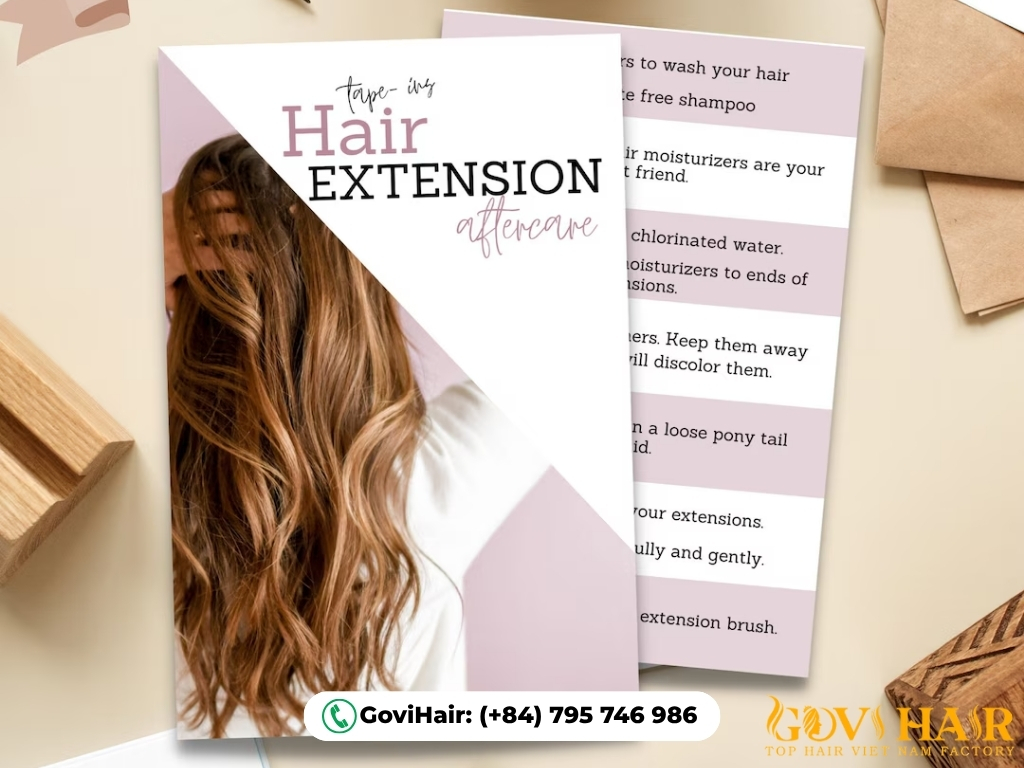
Secrets to a Perfectly Natural Look
How do you hide tape in extensions in thin hair?
To make tape-in extensions blend naturally with thin hair, choose shades and textures that closely match your real hair. Ask your stylist to place the wefts strategically in layers so the tapes stay hidden underneath.
You can also style your hair with light curls or add volume to create thickness, making the bonds completely invisible.
How to Wear a High Ponytail Without Exposing the Tapes
Wearing a high ponytail with tape-in extensions requires a proper hair extension placement for thin hair. Ask your stylist to position the top wefts slightly farther back so they won’t show when you tie your hair up.
Another useful tip is to tease the roots for extra volume and wrap a small section of hair around the base of the ponytail to conceal the tapes.
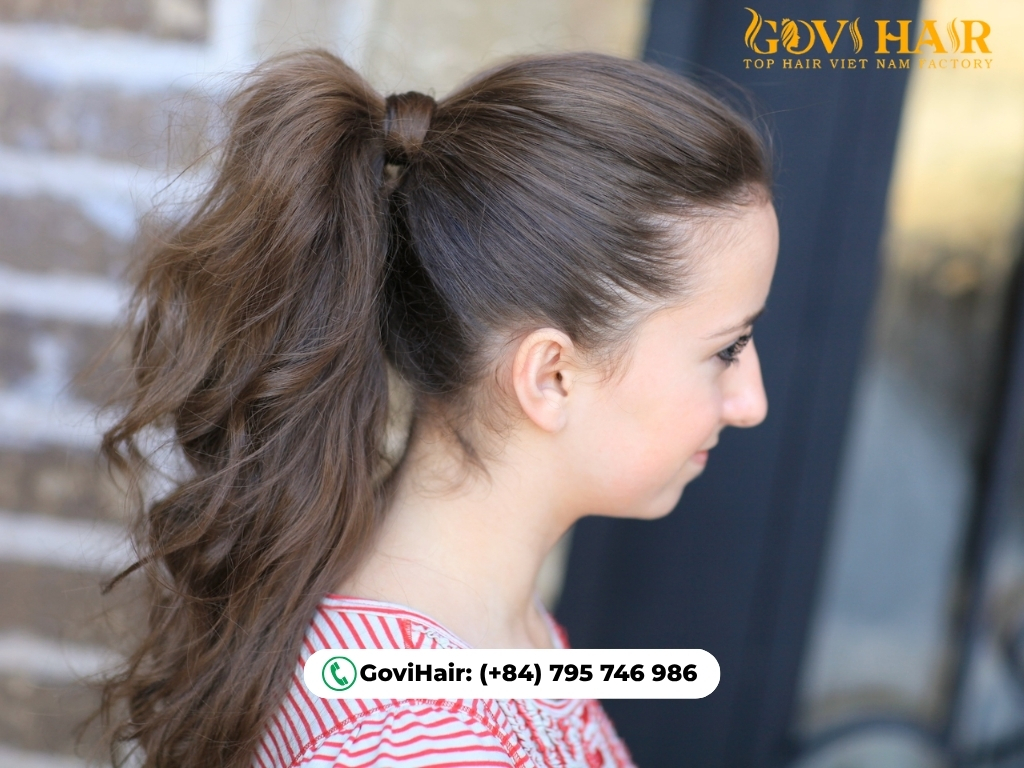
What to Do When Your Hair Grows Out and the Tapes Move Down
As your natural hair grows, the tape-in wefts will gradually slide lower. This is completely normal and usually happens after about 6–8 weeks. The best solution is to book a maintenance appointment at the salon, where the stylist will remove and reapply the extensions closer to the roots.
Remember, never try to pull them out by yourself, as this can damage your hair and lead to breakage.
Common Mistakes When Applying Extensions to Thin Hair
Placing Tapes Too Close to the Scalp or Hairline
Attaching tape-in extensions too close to the scalp or right at the hairline can cause discomfort and make them noticeable. Always leave a small gap from the roots and avoid placing tapes at the very front to achieve a more natural and seamless look.
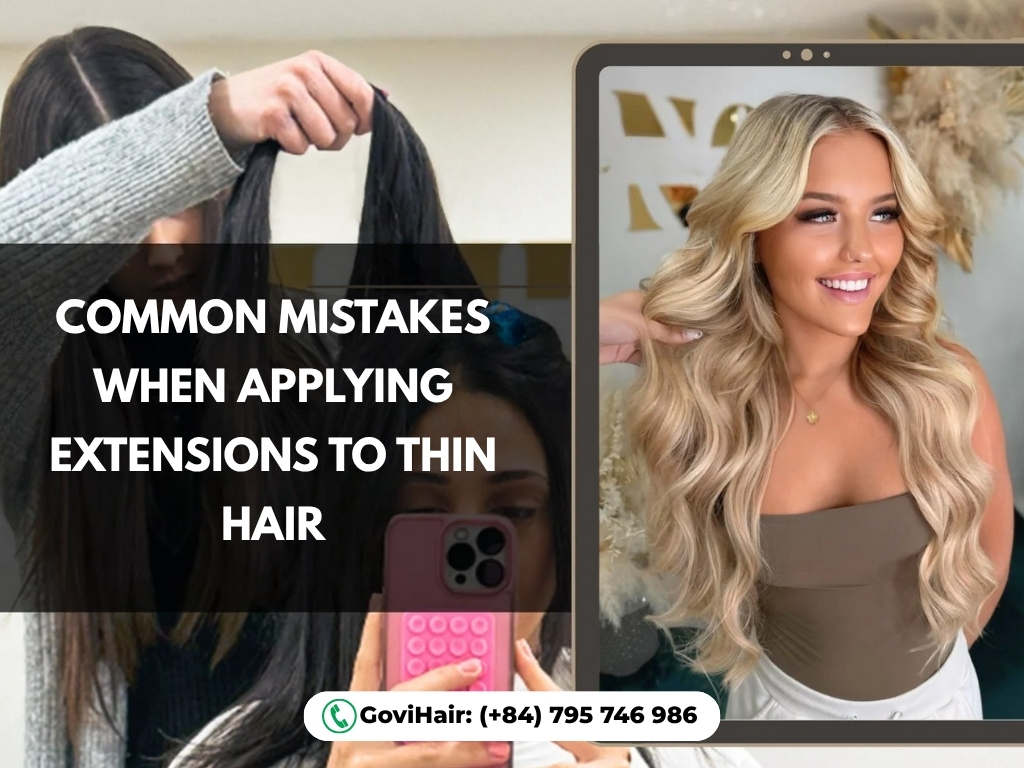
Using Too Much or Too Little Natural Hair Between the Tapes
If too little natural hair is sandwiched between the tapes, the extensions can easily slip out. On the other hand, using too much hair will prevent the tapes from holding securely. The key is to section the right amount of hair to ensure durability and a firm hold.
Misaligning the Tapes
Installing the extensions unevenly or overlapping the tapes can create visible bumps and make them easy to spot. You should place the tapes neatly and press them firmly together to achieve a smooth, invisible finish. Proper alignment will give you a natural, comfortable hairstyle that is difficult to detect.
Why Is Govihair A Top Choice For Tape-in Hair Extensions For Thin Hair
GOVIHAIR – Premium Quality Tape Hair Extensions
- We supply 100% real human hair, no mix, sourced from young women with naturally strong, healthy hair.
- Our tape extensions can last 1 to 3 years with proper care.
- Two tape options available:
Normal Tape – most popular due to its affordability.
Invisible Tape – preferred for clients with fine or thin hair, offering a more natural look.
- Popular lengths: From 18” to 26”.
- Best-selling colors: Black, Brown, Blonde, and Blonde + Brown mix.
- We accept trial orders from 300 grams so you can test the hair quality.
- For orders from 1kg and up, we offer the best price guarantee (beat any price policy).
- Every shipment includes a free care guide booklet to help your clients maintain their extensions.
>> Discover GoviHair’s Premium Collections
Chat With Us:
- WhatsApp: (+84)795 746 986
- Email: [email protected]
- Instagram: gov hair vietnam factory
- Tik Tok: govihairvietnam_official
- Website: https://govihair.com/
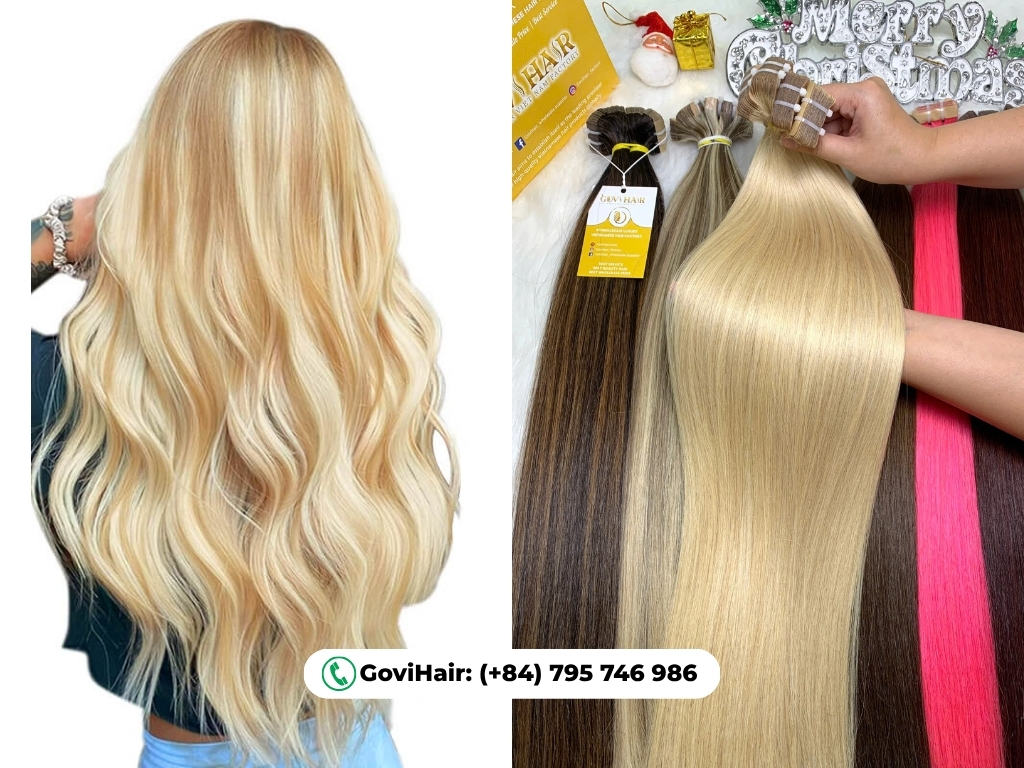
FAQs
Can tape-in extensions be hidden in very fine hair?
Yes. With the right color match, lightweight wefts, and proper placement by a skilled stylist, tape-in extensions can blend seamlessly into very fine hair. Styling tricks like soft waves or added volume also help conceal the tapes.
How often should tape-ins be moved up (re-applied) for thin hair?
For thin hair, tape-in extensions usually need to be moved up every 6–8 weeks as the natural hair grows out.
What types of extensions can actually cause damage to thin hair?
Methods that add excessive weight or tension, such as heavy glue-in, poorly applied keratin bonds, or bulky sew-ins, can strain fragile roots.
Thin hair responds best to lightweight, gentle options like tape-ins or single-sided tape-ins when professionally applied.
Do tape-in extensions feel heavy or uncomfortable on fine hair?
No. Tape-in extensions are one of the lightest and most comfortable methods, especially for fine or thin hair. When applied correctly, the wefts lie flat against the scalp and distribute weight evenly, so you won’t feel heaviness or tension.
Can I still wash and style my hair normally with tape-ins?
Yes. You can wash, blow-dry, curl, or straighten your hair just like with natural hair. You just need to follow a few precautions: use sulfate-free shampoo and avoid applying conditioner or oils directly onto the tape bonds, as this can weaken the adhesive.
Additionally, brush gently and use heat protectant products to keep both your natural hair and extensions healthy and beautiful.
Conclusion
Now you’ve mastered how to apply tape in extensions for thin hair.With the right tape-in extension placement diagram, high-quality products, and proper aftercare, you can achieve a flawless, natural look without damage. Whether you choose standard or single sided tape in hair extensions for thin hair, the key is smart placement and consistent maintenance.
By following these tape-in extensions tips for thin hair, you can enjoy thicker, fuller locks with confidence.









 Ms. Victoria
Ms. Victoria